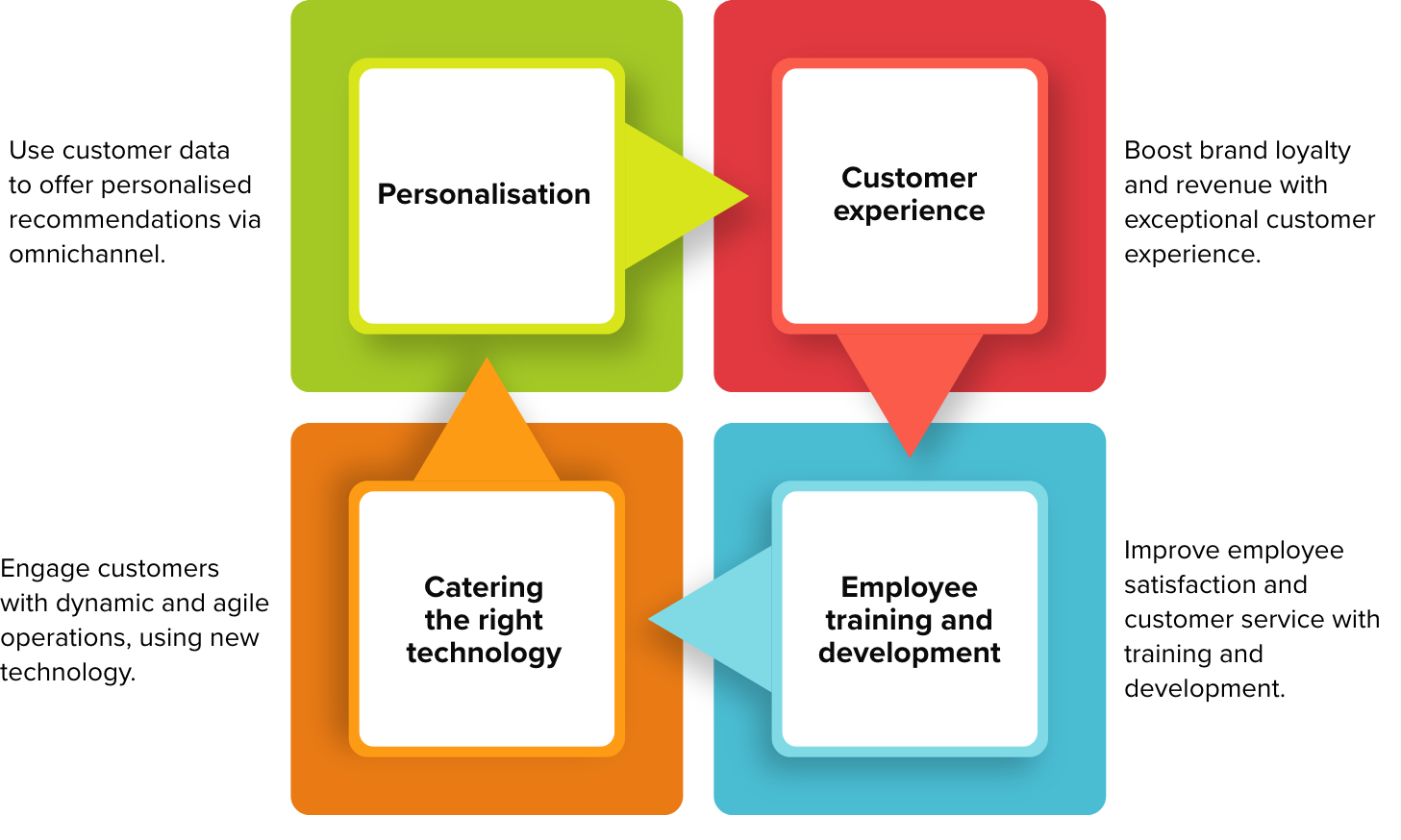Traditionally, the retail sector has focused on enhancing strategic capabilities and operational models to boost sales and profit margins. However, post-pandemic and with the advent of technology, market competition has intensified, and barriers to entry have lowered, compelling retailers to explore new avenues of differentiation such as digital investments, streamlining operations, or adopting new cost structures, but with differing degrees of achievement.
Among the emerging strategies, providing a holistic retail design stands out as a means for retailers to distinguish themselves and offer customers a more all-inclusive and delightful shopping experience. The primary approach is around providing an omnichannel experience.
In this blog, we will explore the benefits of adopting an integrated omnichannel approach for retail, its key elements, and the steps to implement an integrated retail approach.
The Current State of the Retail Industry
The retail industry has undergone significant changes over the past few years due to various factors. Retailers are facing numerous challenges to stay competitive and meet the evolving needs of consumers.
One of the most significant challenges faced by retailers is the increasing popularity of online shopping due to its convenience, wide selection, and competitive pricing.
As a result, traditional brick-and-mortar retailers are finding it difficult to attract customers and remain profitable. Many retailers are now shifting their focus toward online channels and investing heavily in e-commerce capabilities.
Another challenge faced by retailers is changing consumer preferences. Consumers today are more conscious of sustainability, social responsibility, and ethical considerations when making purchasing decisions. Retailers need to adapt their operations to meet these evolving consumer preferences by implementing sustainable practices, ethical sourcing, and socially responsible policies.
Finally, the COVID-19 pandemic has had a significant impact on the retail industry. The pandemic has forced retailers to close physical stores and shift their focus toward e-commerce.
It has also highlighted the importance of technology in retail operations, such as contactless payment and curbside pickup. According to a report by Deloitte, 57% of retailers are planning to invest in artificial intelligence and machine learning in the next two years to improve the customer experience.
Using "Nike Fit," customers can scan their feet and get size recommendations based on measurements.
Retailers that have been able to adapt quickly and implement innovative solutions have been more successful in navigating the challenges posed by the pandemic.
Advantages of incorporating holistic design in retail
Holistic retail design is a comprehensive approach to retail operations that takes into account all aspects of the retail environment, from the products being sold to the customer experience, to sustainability, and employee training. It is a customer-centric approach that focuses on creating a seamless and memorable shopping experience for consumers.
The holistic retail design considers products, customer experience, sustainability, personalization, and employee training.
A key aspect of holistic retail design is an omnichannel approach, which integrates online and offline channels to provide customers with a seamless and consistent experience across all touchpoints. This approach recognizes that customers today are interacting with retailers through multiple channels, and seeks to provide them with a cohesive experience across all of them.
One of the main benefits of this is improved customer experience. Retailers that take this approach can create a more engaging and personalized shopping experience that keeps customers coming back. By understanding the needs and preferences of customers, retailers can tailor their offerings and provide a more positive experience. A Forbes survey states that “77% of consumers consider customer experience to be as important as the product or service.”
Another benefit is improved sustainability. By considering the environmental impact of their operations and products, retailers can implement sustainable practices and reduce their carbon footprint. This can help to attract environmentally conscious consumers and improve the brand image of retailers.
H&M introduced clothing recycling programs in their stores, allowing customers to drop off unwanted clothing for recycling.
Personalization is next. By collecting and analyzing customer data, retailers can provide personalized recommendations and offer that meet the specific needs and preferences of individual customers. This can help to improve customer loyalty and increase sales.
Improved customer satisfaction via employee training and development. By investing in employee training and providing a positive work environment, retailers can improve employee satisfaction and productivity. This can lead to improved customer service and a more positive shopping experience for customers.
By adopting a more comprehensive approach, retailers can improve customer experience, sustainability, personalization, and employee training. By doing so, retailers can create a more engaging and satisfying shopping experience that meets the needs of today's consumers.
Taking Omnichannel Approach
The first step is to assess the current state of the business and identify areas where a more comprehensive approach could be beneficial. This could involve analyzing customer data to understand their needs and preferences, evaluating sustainability practices, and assessing employee training programs.
Retaining data from omnichannel sources and personalizing the experience of your customer. A Forbes survey says, “74% of customers are likely to buy on customer experience alone.”
The next step is to develop a clear strategy that outlines the specific actions and initiatives that will be taken to implement an integrated retail approach. This strategy should be aligned with the overall goals of the business and should be communicated clearly to all stakeholders.
Sephora's Virtual Artist app allows customers to try on makeup virtually, allowing them to see how different products will look before making a purchase.
Once the strategy is in place, retailers can begin to implement the necessary changes to their operations. This could involve introducing new technologies, implementing sustainable practices, and providing additional employee training and development opportunities.
It is also important to continuously monitor and evaluate the success of the comprehensive retail approach and adjust as needed. This could involve analyzing customer feedback, tracking key performance indicators, and identifying areas for improvement.

Implementing a healthy retail approach involves assessing the current state of the business, developing a clear strategy, making necessary changes, and continuously monitoring and evaluating success. By taking these steps, retailers can create a more engaging and satisfying shopping experience that meets the need of today's consumers.
- Buy Online, Pick Up In-Store: Customers can browse products online and then pick up their purchases at a nearby store, allowing for a more seamless and convenient shopping experience.
- Walmart offers Buy Online, Pick Up In-Store at many of its locations. Walmart also offers a curbside pickup option for added convenience.
- Walmart offers Buy Online, Pick Up In-Store at many of its locations. Walmart also offers a curbside pickup option for added convenience.
- In-Store Kiosks: Retailers can offer in-store kiosks that allow customers to browse and purchase products that may not be available in-store, creating a more comprehensive product offering.
- McDonald's self-service kiosks in some of its stores, allow customers to place and customize their orders without the need for a cashier.
- McDonald's self-service kiosks in some of its stores, allow customers to place and customize their orders without the need for a cashier.
- Virtual Try-On: Retailers can use augmented reality technology to allow customers to try on products virtually, such as clothing or makeup, creating a more immersive and interactive shopping experience.
- Sephora is a beauty retailer that offers in-store kiosks that allow customers to browse and purchase products. Sephora's Virtual Artist app allows customers to try on makeup virtually using their phone's camera, allowing them to see how different products will look on their skin before making a purchase.
- Sephora is a beauty retailer that offers in-store kiosks that allow customers to browse and purchase products. Sephora's Virtual Artist app allows customers to try on makeup virtually using their phone's camera, allowing them to see how different products will look on their skin before making a purchase.
- Personalized Recommendations: Retailers use customer data to provide personalized recommendations across all channels, including email, website, and social media. This helps customers discover new products they might not have found otherwise and improves their overall shopping experience.
- Nike's "Nike Fit" feature allows customers to scan their feet using their smartphone camera and then recommends the best shoe size for them based on their measurements.
- Nike's "Nike Fit" feature allows customers to scan their feet using their smartphone camera and then recommends the best shoe size for them based on their measurements.
- In-Store Digital Experience: Retailers use digital technology in their physical stores to enhance the shopping experience. For example, customers can use digital displays to see product information and reviews, scan QR codes to access additional product details, and use mobile apps to make purchases or join loyalty programs.
- Mobile checkout: Retailers can offer mobile checkout options that allow customers to complete their purchases on their phones, eliminating the need to wait in line.
- Mobile checkout: Retailers can offer mobile checkout options that allow customers to complete their purchases on their phones, eliminating the need to wait in line.
These are just a few examples of the omnichannel strategies that retailers are using to create a seamless and convenient shopping experience for their customers across all channels.
Overall, an omnichannel strategy in retail seeks to provide customers with a seamless and consistent shopping experience across all touchpoints, creating a more convenient, personalized, and memorable experience for the customer.
Future of Retail
Retailers will need to focus on providing a consistent brand experience across all channels, including social media, mobile apps, and physical stores.
As retailers adopt new technologies to enhance the shopping experience and meet changing customer expectations, here are some potential developments:
- Online and Offline Integration: Retailers will continue to integrate online and offline channels to provide customers with a seamless shopping experience. For example, retailers may use augmented reality to allow customers to "try on" products virtually, or offer personalized recommendations based on customer data.
- Automation: Retailers may use automation and robotics to streamline processes such as inventory management and order fulfillment, reducing costs and improving efficiency.
- Artificial Intelligence: Retailers may use artificial intelligence to analyze customer data and behavior, and tailor the shopping experience accordingly. For example, they may offer personalized product recommendations, or use chatbots to provide customer service.
- Contactless Payments: With the ongoing pandemic, contactless payments are likely to become more widespread, with retailers adopting technologies such as mobile payments and QR codes to minimize physical contact.
As retailers continue to innovate and adapt to changing customer expectations, integrating technology is likely to remain a key part of the future of retail. Overall, the future of retail with the help of technology is likely to be characterized by greater convenience, personalization, and innovation, as retailers continue to adapt to changing customer expectations and embrace new technologies.
Conclusion
In conclusion, the retail future is becoming more holistic as it should be and there still is a long way to go. Retailers focus on a more comprehensive approach that goes beyond simply selling products. This approach involves a focus on customer experience, personalization, sustainability, technology, and employee training, and requires a clear strategy and commitment from all stakeholders.
While there may be challenges in implementing an integrated retail approach, the potential benefits are numerous, including improved customer loyalty, a more sustainable business model, and a positive brand image.
Overall, retailers that adopt an aggregate retail approach are better positioned to succeed in the competitive retail landscape of the future.
If you're looking to take your retail strategy to the next level, we'd love to hear from you! Contact us today at [email protected] to learn how we can help you create a seamless omnichannel experience for your customers.
Subscribe
Related Blogs
Exploring Drupal's Single Directory Components: A Game-Changer for Developers

Web development thrives on efficiency and organisation, and Drupal, our favourite CMS, is here to amp that up with its latest…
7 Quick Steps to Create API Documentation Using Postman

If you work with API, you are likely already familiar with Postman, the beloved REST Client trusted by countless developers…
What is Product Engineering Life Cycle?

Imagine constructing a house without a blueprint or a set of plans. It will be challenging to estimate the cost and labor…



